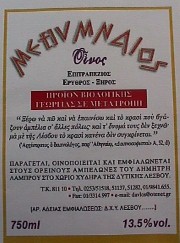
Painting by Moriatis
| I am a wine drinker. I drink ouzo too but generally I do that before dinner or else in Lesvos where it is more of a tradition then wine due to a blight that wiped out the grapes several hundred years ago. But my favorite activity is eating in a taverna with my friends and drinking wine. My favorite tavernas have their own wine, straight out of the barrels, which are usually stacked against the wall. We order it by the kilo and we can go through several kilos in an evening. Glasses are continually being refilled by each other without anything being said. It's like a reflex or second nature to fill your neighbors glass when you see it is empty. And when the carafe is empty someone at the table just lifts it in the air and catches the eye of a waiter, the busboy or even the owner of the restaurant and in thirty seconds it is full again. | 
Painting by Moriatis |
| Retsina is my preferred wine and most
of the time that is what is available in those barrels. But many tavernas
also have an excellent red, or a white which is not resinated. Most restaurants
are proud of their wine though not all the restaurants make their own.
Some buy it from distillers by the barrel or by large jug, and in some
touristy restaurants homemade wine, or hima, as it is called, is
not even available and you have to take your chances with the wine list.
There have been many explanations as to why retsina tastes the way it does. The explanation is because they put pine resin in it to make it taste like that and the reason is because they like the taste. Some people have come up with theories on how this all began. When we were kids we heard (from other kids of course) that during world war two the Greeks put the resin into the wine so the Germans would think it was turpentine and not drink it. That was a romantic theory but not a good one. But according to Vassilis Kourtakis, who makes the most popular of the bottled retsina, the ancient Greeks knew that the air was the enemy of wine and used pine resin to seal the tops of the amphora and even added it to the wine itself. |
| Retsina was the wine of Athens. As far
back as the late 1800's Athens had over 6000 tavernas, all filled with
wine barrels. The grapes were pressed in the countryside and then brought
into the city by horse-drawn carts, before the fermentation had taken place
and then taken to the restaurants where the proprietor poured in the resin
and decided when the wine was ready. It was not until the 1960's that bottled
retsina became available in the countryside and common in the city as many
of the old tavernas disappeared and land for cultivating wine near Athens
became scarce.
Nowadays retsina from the barrel is hit or miss. But if you go to a taverna and it is full of happy Greek people drinking from glasses that are being refilled over and over again from a carafe then chances are the retsina is pretty good. When it's not, mix it with soda water like I do. This also will enable you to drink all night long. One of the things I have noticed is that I can drink a lot of retsina and still not be hung over the next day. My kidneys may hurt like hell but otherwise I feel great, considering. |
THE ILLUSTRATED GREEK WINES BOOK
|
Favorite Wines of Nico Manessis
|
Antonopoulos Chardonnay: Green gold in color. Lime and sweet oak on the nose. Lemon fruity richness-a palate full of roasted hazelnuts. Elegant. World class.
Antonopoulos 1997 Cabernet-Nea Dris: Playful nose features eucalyptus and red berries. Balanced, multi-layered, ripe tannins. Dazzling concentration, freshness and depth. Best from 2002.
Arghyros 1998 Santorini Vareli: Nose reminiscent of Chardonnay and lemon. Spice and white pepper on the palate. Yeasty. Toasty. Atypical. A cosmopolitan Santorini. World Class.
Dalmaras 1992 Naoussa: Deep color. A complete nose alternating mulberry and leather. Compact, velvety smooth tannins have a gamy richness. A great bottle, best from 2000.
1997 Gaia Estate: Delivering both power and velvety texture, this serious, fine, unfiltered wine has raised the stakes in the Nemea Appellation. Best after 2004. The 1998 vintage-tasted in cask- is even more concentrated.
Lazaridis Amethystos Cava: Almost black. Pure fruit evokes the essence of Cabernet Sauvignon. Skillful use of oak. Exquisite, long, smoky end-taste. Unfiltered. Much finesse.
Tselepos 1998
Mantinia: Seductive, exotic, floral nose. Violets bursting with
grapes and fruit on the palate. Extended bone-dry Muscat aftertaste and
searing acidity that goes on and on. A bold Mantinia from this ultra-ripe
vintage.
 |
Matt's Favorite WineThe island of Lesvos was renown in antiquity for it's wine. It is claimed the island had the finest soil and climate for growing grapes and the wine from Lesvos was the most treasured in the wine cellars of the Byzantine Emperor. Unfortunately a blight killed all the grapes on the island and wine-making on Lesvos died out, one reason why ouzo is now the drink of choice there. But in the remote agricultural village of Xidera something very special has happened. Dimitri Lampou has been paying farmers in the area to grow grapes again using a disease resistant strain. He has built a state-of-the-art winery in this village and has begun production of what I think is one of the best red wines I have ever tasted. Of course I don't have the expertise of Mr Manessis, but I know what I like and I think if you try this wine you won't be disappointed. The wine is called Methemnaos and was available in Lesvos and by the time you read this may be available elsewhere in Greece too. |
 |
 |